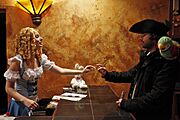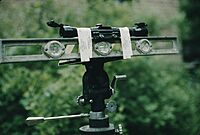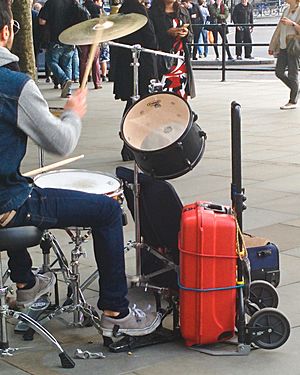Improvisation facts for kids
Improvisation, often called improv, is when you make or do something without planning it first. It's like thinking on your feet and using what you have right now. The word comes from a Latin word meaning "unforeseen," and it's also linked to the word "improve." In arts like acting or music, improvisation means performing without a script or much preparation. These skills can be used in many areas, from art and science to sports and daily life.
Contents
Skills and How We Use Them
Improvisation skills can help you in many different parts of life. For example, you can use improv in music, dance, cooking, giving a speech, or even playing sports. It's about being creative and flexible!
When you "extemporize" or "ad lib," you are basically improvising. Other common phrases like "playing by ear" or "making it up as you go along" also describe improvisation.
Even when you are just talking, you use a lot of improvisation. Your mind creates new thoughts and words as you speak. This is like composing something new right away, using words and ideas you already know.
Sometimes, improvisation helps solve a problem quickly when the perfect solution isn't available. This is often called a "stop-gap" solution. For example, in engineering, you might use available tools to fix something temporarily.
Another way groups use improvisation to solve problems is called brainstorming. In brainstorming, everyone shares any idea they have, no matter how wild it seems. This helps people think of new, unexpected, and useful ideas. It's like "thinking outside the box"!
Improv in Arts and Entertainment
Improvisation in the arts is a sudden, creative idea that comes to you in the moment. It's like a spark of inspiration! Viola Spolin created special theater games to teach actors how to improvise. Her son, Paul Sills, helped make improvisational theater popular. He used Spolin's methods to train actors at The Second City in Chicago. This was the first theater group in the US fully focused on improv.
You can get better at improvisation by practicing it. This means learning to trust your gut feelings and understanding the skills needed for what you are doing. This applies whether you are acting, dancing, singing, playing music, or solving problems. It can lead to new ideas, new ways of doing things, and new ways to express yourself.
Music Improv
Musical improvisation is when musicians play music without any written notes or practice. It's like composing music "on the fly." Scientists have even studied what happens in the brain during musical improvisation. They found that a part of the brain linked to self-expression becomes more active. Another part, which usually stops us from taking risks, becomes less active. This helps musicians feel free to create new sounds.
Musicians can improvise alone or with a group. When done well, it can be very exciting for the audience. Famous improvisational pianists include Franz Liszt and Keith Jarrett. Even in silent films, musicians like Neil Brand improvise music to match the movie's mood and speed.
Rappers also often improvise freestyle rap. They make up rhymes and lyrics on the spot. This can be for fun, for practice, or even in rap battles.
Theatre Improv
In theatre, improvisation means acting out scenes without a script. Actors create the dialogue and actions as they go. This method has been used in theatre for many different reasons throughout history.

Comedy Improv
Improvisational comedy is a popular type of theatre performed all over the world. Many famous improv theaters and training centers exist. Some well-known ones include i.O. and The Second City in Chicago.
Many universities also have improv teams. The Compass Players, which led to The Second City, started from theatre programs at the University of Chicago in the 1950s. Today, improv groups are a common and fun activity on college campuses.
Many famous comedians and actors started in improv. Some pioneers include Viola Spolin and Paul Sills. Well-known performers who use improv skills include Stephen Colbert, Steve Carell, Bill Murray, and Robin Williams.
Dance Improv
Dance improvisation is a tool used in creating dances. Dancers move freely without planning, exploring different shapes, spaces, and energies. This helps choreographers (dance creators) find new and unique movements. It allows them to connect with their deepest creative ideas.
Contact improvisation is a special dance form developed in 1973. It's based on dancers sharing weight and exploring movement together. It's all about playing with balance and unexpected outcomes.
Sculpture Improv
Sculptors sometimes improvise when working with materials like clay. Instead of following a small model exactly, they let the clay guide them. This allows new and unexpected forms to appear as they work. It's a way to keep the creative process alive and open to surprises.
Film Improv
Some film directors use improvisation to create their movies. For example, director Mike Leigh works with actors for weeks. They improvise scenes to build their characters and story lines. The actors discover their characters' fates as they go. The final film then uses dialogue and actions that came from these improv sessions.
Writing Improv
Improvisational writing is an exercise where writers create text with certain rules. For example, they might have a time limit, a word limit, or a specific topic. This helps writers overcome writer's block and boosts their creativity. It also strengthens their writing instincts and makes them more flexible.
Some improvisational writing is done with a group. This can be as simple as passing a notebook around, with each person writing a sentence. Or it can be more complex, like online environments where people work together to write a novel.
Improv in Science and Technology
Engineering Improv
In engineering, improvisation means solving a problem using only the tools and materials you have at hand. A famous example is how engineers on the Apollo 13 space mission improvised a way to fix the carbon dioxide scrubbers using parts from the spacecraft. Another simple example is using a knife instead of a screwdriver to turn a screw.

Engineers might need to improvise during emergencies or when they can't get the right parts. This can happen if a product is old and no longer supported by its maker. Or it might be due to a lack of money for a better solution. In some parts of the world, car owners often improvise repairs because official spare parts are hard to find.
The TV show MacGyver was famous for its hero. He could solve almost any problem by building clever devices from everyday items, a Swiss Army knife, and some duct tape.
Artificial Intelligence Improv
Scientists are even exploring how AI can improvise. This field is called Machine improvisation.
See also
 In Spanish: Improvisación para niños
In Spanish: Improvisación para niños




